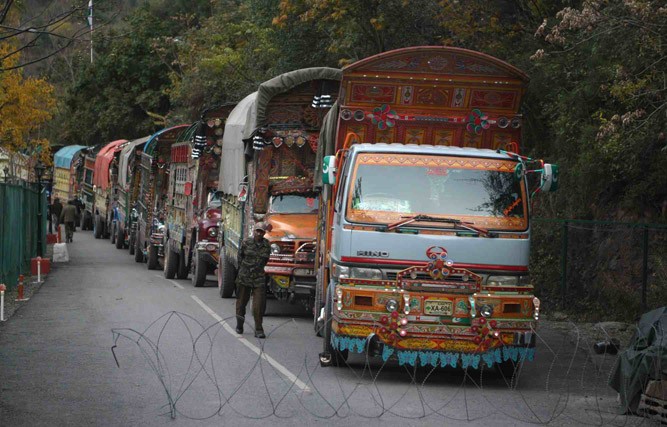
The current situation in Kashmir Valley should not be used as a pretext to stop trade and travel across Line of Control

Sustained violence, killings and protests in Indian occupied Kashmir are making huge impact on the sociopolitical life of Azad Jammu and Kashmir. Protests, sit-ins and seminars are being held across the region almost everyday either to show solidarity with the embattled people of Kashmir or condemn blatant human rights violations.
Ironically, some of the organisations are collecting food items, clothes and funds to support people of Kashmir, knowing the hard reality that there is no means to send collected stuff and donations across the Line of Control (LoC). The government is looking the other way around instead of preventing these activities mostly conducted by outlawed organisations in the name of Kashmir cause.
A few political outfits are trying hard to highlight non-issues out of proportion merely to stay relevant in the discourse. Recently, a group of people led by a few All Parties Hurriyat Conference representatives based in Islamabad went to Muzaffarabad, the capital of AJK, to hold a protest against the LoC trade and travel which happens to be the only link between the two parts of the divided Stated of Jammu and Kashmir. They urged authorities to stop LoC trade which was started on the demand of Kashmiris in October 2008.
Due to the social and political pressure generated by these outfits, trade has been halted till Eid-ul-Azha but anti-trade and travel campaign did not go down well across the LoC. A number of commentators termed it a myopic move by the vested interest groups who lack political imagination and intellectual depth.
The tangible outcome of peace process and negotiations between India and Pakistan, spanning over several decades, is three significant confidence-building measures (CBMs). In November 2003, a ceasefire along the Line of Control was pronounced by Islamabad and New Delhi, in April 2005 two crossing points were opened for the divided families to travel across the LoC on a permit issued by local authorities while in October 2008, the governments of India and Pakistan made another landmark decision by allowing Kashmiris to trade with each other across LoC through two points, namely Chakothi-Slamabad and Tetrinote-Poonch.
Since 2005, India-Pakistan relations and the Kashmir situation witnessed several ups and downs. It touched the lowest ebb in the aftermath of the 2008 Mumbai attacks. However, despite all odds, cross LoC travel and trade survived which was not less than a miracle.
Although the tariff free and barter trade between two parts of the erstwhile State of Jammu and Kashmir is limited, it has given a sense of achievement to the inhabitants of the region. It also offers an alternative route and a new outlet to Indian occupied Kashmir to trade with the outside world through Pakistan. Even during crisis, particularly in the wake of natural catastrophe, these routes are key to rescue people and give relief on the either side of the LoC.
In 2014, Kashmir suffered a massive torrential rainfall which turned into a disastrous flood. Previously, an earthquake wherein over 50,000 people died, hit Azad Jammu and Kashmir. At that point of time, five crossing points were established along the LoC. People were permitted to stay for 45 days within a year on either side of the LoC. Recently; triple entry permit was also introduced to facilitate frequent travelers, particularly the divided families.
An official of Trade and Travel Authority (TATA), a government body responsible to regulate trade and travel between two parts, revealed that 25000 people have travelled through these crossing points so far and not a single unpleasant incident has been recorded.
Apart from business benefits, the opening of the LoC has greatly contributed to reunite families across the borders. Mahmood Ahmad Dar, a prominent Kashmiri businessman, said he got a chance to meet his family after 22 years due to the trade and travel CBM. "This is not merely trade between two persons or companies, rather it has huge emotional value and has become a connector between divided families," Dar maintained. His mother travelled to Pakistan to meet his grandchildren after 25 years.
An ex-judge of Lahore High Court, Justice Sharif Hussain Bukhari, said that he migrated from Indian held Kashmir to Pakistan immediately after the partition of British India. He went to Srinagar after 58 long years when Srinagar-Muzaffarabad bus service was launched.
The cross LoC trade ensured ceasefire along the 786-kilometre long Line of Control as trade and travel cannot be conducted in a hostile environment. A large number of conflict affected people, particularly small traders, living close to the LoC got engaged in the trade and earned decent livelihood. The Trade and Travel Authority (TATA) revealed that over 500 local traders are engaged in the LoC trade. Despite all limitation and hostility, the LoC trade volume has crossed 57 billion PKR during last eight years.
A New Delhi-based Kashmiri journalist, Iftikhar Gilani, stated that it is the only CBM, which challenges status quo mentality and helps policy-makers to think creatively in order to find fresh solution to an old dispute. Besides, it gives Pakistan a great deal of access to Kashmir markets where its good are sold like hot cake.
Although, the current situation in Kashmir Valley is highly deplorable, it should not be used as a pretext to reverse the gains which people of Kashmir have achieved as a result of a long drawn struggle, sacrifices and immense suffering. The linkages between two parts should be further strengthened as it helps peoples of the divided Kashmir to enhance mutual political and social understanding.